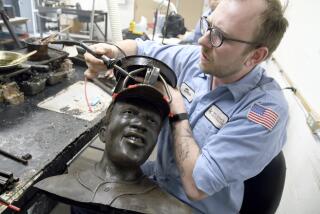Horse Thief Societies Spur On Tradition
- Share via
KINDERHOOK, N. Y. — “The 167th annual meeting of the Schodack, Stuyvesant, Kinderhook and Chatham Society for the Detection of Horse Thieves is hereby called to order. Any old business?”
“Not since that horse was stolen 73 years ago.”
“New business?”
“Not till the next horse is stolen.”
“What’s on the menu this year?”
“Same as always. Minced-ham sandwiches, clam chowder and oyster stew.”
“Meeting’s adjourned. Let’s put on the feed bags!”
That’s as lively as it gets these days at meetings of the horse thief trackers of Columbia County, 30 miles south of Albany. The group has met on the first Saturday in February since 1824, when the most serious pollution was what landed behind a carriage on a dirt road.
“It’s just a tradition,” said the society’s president, Lewis Leggett, 78, who couldn’t remember just when he joined the group. The last time anyone called on the society to track a stolen horse was in 1917, while Henry Ford was busy causing stables to be converted into garages.
In neighboring Dutchess County, Woody Klose, president of the Red Hook Society for the Apprehension and Detention of Horse Thieves, credits his group with keeping the horse theft rate low.
“It’s got to be the greatest organization in the world,” said Klose, a lawyer and county legislator. “It meets just once a year and we haven’t had a horse theft in years. Thieves are so terrified of us that they leave our horses alone.”
A Columbia County mule went missing in the 1930s, but came home by itself. One year someone stole the hobbyhorse off a villager’s porch. Another year, a society member stole the group president’s old gray horse as a joke. The prankster wasn’t hanged or even horsewhipped.
About 10 years ago, a couple of horses were stolen from a local breeding farm, but police didn’t call on the volunteers for help.
“I think they figured the troopers could do a better job,” society secretary Ralph Duck said.
And “with the state of modern law enforcement,” Klose said, “we don’t take things into our own hands any more.”
Still, the Columbia County group has nearly 200 members who enjoy meeting with old friends they otherwise wouldn’t see, said Duck, 79, who joined about 50 years ago.
It all started when eastern New York was still on the frontier and horse thieves roamed the farm country along the Hudson River. A horse then was practically part of the family, essential to both transportation and farm work.
“You could probably get away with stealing a man’s wife easier than stealing a man’s horse,” Leggett said. “If you lost your horse, you lost your heart.”
Unable to afford full-time posses, the farming villages formed societies--not unlike volunteer fire departments--to trail horse thieves.
Each year, the societies elected riders who would be called in when a horse was stolen. The Columbia County society paid its riders $2 a day while they were on the trail. Red Hook riders earned more money the farther they rode. They got a bonus if they trailed a horse thief out of Dutchess County and brought the bandit back home, Klose said.
The societies also acted as insurers. They paid farm families to replace stolen horses.
As automobiles and tractors replaced horses in the early 1900s, most of the horse theft societies folded.
On today’s thoroughbred farms there are few worries about stolen horse flesh. It’s tough to launder a stud horse because its value depends on careful documentation of its parentage.
The Columbia County society still has its noose for hanging horse thieves, but no member can recall when--or if--it was used. “I’ve always had the feeling they didn’t hang them around here like they did in the Wild West,” Duck said.
And the minutes of Red Hook society meetings are “terrific about writing down who didn’t show up, but they don’t say anything about catching horse thieves,” Klose said.
“I can’t find any report of a member ever having done anything,” he said.
Although the posses of Columbia and Dutchess counties don’t expect to be saddling up any time soon, a feeling of continuity keeps the 65 members of the Red Hook society, founded in 1796, coming to their roast beef dinner on the first Tuesday of October every year, Klose said.
“We still live in what we like to think of as a semi-rural area,” he said. “It makes you feel good because you can go back to minutes from seven or eight generations ago and find the same names as people attending our meetings today.”
More to Read
Sign up for Essential California
The most important California stories and recommendations in your inbox every morning.
You may occasionally receive promotional content from the Los Angeles Times.













